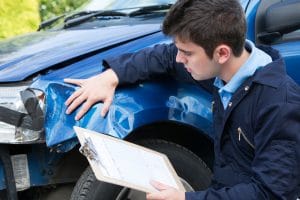What You Need to Know About Diminished Value Claims After Your Austin Car Accident

Suffering injuries from a car accident that was not your fault is frustrating. You sustain painful injuries, and your vehicle is damaged because of the negligence of another driver. You are inconvenienced, in pain, and incur financial losses.
If someone hits your car, you are entitled to seek compensation for damages. Damages include loss of income, medical bills, physical pain, emotional suffering, and other damages related to your injuries, as well as property damage.
Property damage claims refer to the damage to your vehicle or other personal property. These claims are generally settled quickly. However, many individuals overlook diminished value claims when settling a property damage claim after a car accident. Continue reading to find out what you may need to know about diminished value after a car accident.
What Is a Diminished Value Claim?
 Car repairs might make your vehicle look as if it was never in a crash, however, there could be underlying problems that might surface at a later date. At the very least, the car’s value diminishes because it has been in an accident.
Car repairs might make your vehicle look as if it was never in a crash, however, there could be underlying problems that might surface at a later date. At the very least, the car’s value diminishes because it has been in an accident.
When you decide to sell your vehicle, the purchaser is likely to check the accident record. Buyers, including private individuals and car dealers, are not as willing to pay as much for a vehicle that has been involved in a car accident.
A diminished value claim is a demand for payment of the difference between what your vehicle was worth before the accident and your vehicle’s value after the accident. Before you file a diminished value claim, it is helpful to understand more about diminished value.
Three Types of Diminished Value
After a car accident, there are three types of diminished value that might apply in your case. Those types are:
- Immediate Diminished Value – the difference in the resale value of the vehicle without making any repairs.
- Inherent Diminished Value – the loss of market value or worth of the vehicle.
- Repair-Related Diminished Value – the loss of the vehicle’s value because of faulty repairs, including using used parts for repairs and leaving items unrepaired.
Inherent diminished value claims are the most common type of diminished value claim because a car has less worth due to the history of damage and repairs.
Texas Law Applying to Car Accident Claims
Texas is an at-fault state for car accident claims, which means that the person who caused the accident is legally and financially responsible. For that reason, Texas requires drivers to purchase a minimum amount of liability car insurance.
Liability insurance compensates other drivers and accident victims when you cause a car accident. The minimum liability car insurance requirements for Texas are:
- $30,000 for the bodily injury to one person
- $60,000 for bodily injury per accident
- $25,000 for damage to property
Filing a Diminished Value Insurance Claim
Depending on the details of your case, you may need to file a first-party insurance claim or a third-party insurance claim. Read below to know which claim applies to you:
What Are First-Party Insurance Claims?
First-party insurance claims for diminished value are filed when you are at fault for the cause of the car crash. The claim is filed against your insurance coverage. You must have car insurance covering property damage when you cause a car accident, such as comprehensive coverage or collision coverage.
What Are Third-Party Insurance Claims?
A third-party claim is filed when you are not at fault for the cause of the accident. The claim is filed with the car insurance provider for the other driver. To receive compensation through a third-party insurance claim, your car accident lawyer will have to prove that the other driver was at fault.
Evidence for Diminished Value Claims
 Before filing a third- or first-party diminished value claim, you need to gather evidence to prove that the value of your vehicle decreased because of the accident. In most cases, an insurance company requires at least two or three estimates from reputable sources. Car dealers are good sources, especially if they sell your make and model vehicle.
Before filing a third- or first-party diminished value claim, you need to gather evidence to prove that the value of your vehicle decreased because of the accident. In most cases, an insurance company requires at least two or three estimates from reputable sources. Car dealers are good sources, especially if they sell your make and model vehicle.
When the car dealer calculates the diminished value of your car, factors that the dealer might consider include:
- The vehicle’s make and model
- The current mileage of your vehicle
- Any history of car accidents or damage
- The age of the vehicle
- The condition of the vehicle before the accident
- The quality of the repairs and the parts used to make the repairs
- The vehicle’s value if it was not damaged
- The market demand for the vehicle
Several types of vehicle damage may result in diminished value, impacting the car’s resale or market value. Common factors include structural damage, cosmetic damage and frame damage. Significant damage to the structural integrity of the vehicle can reduce its value, even if repairs are made. If the vehicle’s frame has been compromised, even after repairs, it may still experience diminished value due to potential long-term effects on performance and safety.
How Is Diminished Value Estimated?
Because each vehicle is different and the repairs are unique to the accident, there is no standard formula for calculating diminished value. Insurance companies might use a specific method for calculating diminished value. However, that method might not consider all factors that impact the value of a vehicle after an accident, so it is in your best interest to have multiple estimates from different sources to fight for the compensation you deserve.
Written estimates are essential to have before you file your diminished value. You need to know whether the insurance company is offering a fair amount for the claim or if it is attempting to undervalue the claim. Professional appraisers or diminished value experts use multiple factors to calculate the diminished value accurately. If you’re pursuing a claim for diminished value, consulting with experts and seeking guidance from a personal injury lawyer can help ensure a fair assessment and appropriate compensation.
Do I Need a Lawyer to File a Diminished Value Claim?
 Some attorneys only represent property damage claims if they also represent the clients for their personal injury claim. When you hire a car accident attorney to handle the personal injury claim, you should discuss a diminished value claim with the attorney before approaching the insurance company.
Some attorneys only represent property damage claims if they also represent the clients for their personal injury claim. When you hire a car accident attorney to handle the personal injury claim, you should discuss a diminished value claim with the attorney before approaching the insurance company.
If you were not injured in the accident, you could have trouble finding an attorney to accept the case. However, that does not mean you should not try to talk with a property damage attorney before filing a diminished value claim.
When you approach the insurance company about a diminished value claim, you or your lawyer should have your estimates and evidence ready. In addition to your estimates, other evidence might include:
- Invoices showing aftermarket parts were used to make the repairs
- Photographs of the damage to the vehicle
- Statements from mechanics explaining how the repairs negatively impact the car’s performance
- Photographs of the repairs that do not return the car to the same condition as before the accident
Insurance companies often deny these claims because they know that many attorneys do not take these cases. They also believe that individuals will give up and stop pursuing the claim.
Do not give up, and do not wait too long to pursue your claim. Most property damage claims must be filed within two years of the date of the damage, according to the Texas statute of limitations. If you do not file your claim before the deadline, you lose the right to pursue legal action for diminished value after a car accident.
In an Accident? Contact Lorenz & Lorenz Accident & Injury Lawyers PLLC Today!
Our team of experienced car accident attorneys is ready to help you through your car accident claims. If you have suffered injuries and damages from a car accident that wasn’t your fault, contact Lorenz & Lorenz Accident & Injury Lawyers PLLC today. We offer a free case review so you can determine your next best steps at no cost to you. We’re on top of it!
